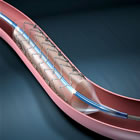| << To Blog Home >> | |
|
|
December 6, 2010 -- 1:15pm EST Kick-Ass Stents Hello PR Department. I've got a number of thoughts about all this and will post a more extensive commentary later on, but one major issue in this whole saga is whether or not the stent placements were "unnecessary", and I ask readers to go back to my October post. Doctors can disagree on whether a stent is called for -- especially when they are being guided by the angiogram (X-ray image). And in Midei's case, two sets of well-known and highly-respected cardiologists have disagreed in most of the disputed cases. But a technology exists that would have added a whole data set to these cases: it's called Fractional Flow Reserve (FFR) and it yields a number that can be used as a decision-point about whether to stent or not. The technology is backed up by two-year results from a major study (FAME) that showed improved outcomes with less stents when decision-making was guided by FFR instead of angiography alone -- and the use of FFR has been bolstered by an increased level of evidence from the recent AHA/ACC/SCAI Guidelines Update. So why is it used in only 15% of cath labs? More later.... |
|


 I
wrote about this issue over a month ago (see "
I
wrote about this issue over a month ago (see "